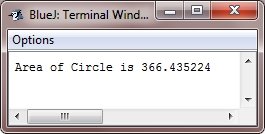- Java Programming Basics
- Java Tutorial
- Java Overview
- Java Environment Setup
- Java Program Structure
- Java Basic Syntax
- Java First Program
- Java Constants
- Java Separators
- Java Keywords
- Java Data Types
- Java Data Types
- Java Integers
- Java Floating Point
- Java Characters
- Java Booleans
- Java Numbers
- Java Programming Variables
- Java Variables
- Java Variable Types
- Java Variable Scope
- Java Type Conversion
- Java Type Casting
- Java Auto Type Promotion
- Java Type Promotion Rules
- Java Programming Arrays
- Java Arrays
- Java One Dimensional Array
- Java Multidimensional Array
- Java Programming Operators
- Java Operators
- Java Arithmetic Operators
- Java Increment Decrement
- Java Bitwise Operators
- Java Left Shift
- Java Right Shift
- Java Relational Operators
- Java Boolean Logical Operators
- Java Ternary(?) Operator
- Java Operator Precedence
- Java Control Statements
- Java Decision Making
- Java if if-else if-else-if
- Java switch Statement
- Java Loops
- Java while Loop
- Java do-while Loop
- Java for Loop
- Java for-each Loop
- Java Nested Loops
- Java break Statement
- Java continue Statement
- Java Class Object Method
- Java Classes and Objects
- Java Class
- Java Object
- Java new Operator
- Java Methods
- Java Constructors
- Java this Keyword
- Java Stack
- Java Overloading Recursion
- Java Method Overloading
- Java Constructor Overloading
- Java Object as Parameter
- Java Call by Value Reference
- Java Returning Objects
- Java Recursion
- Java Modifier Types
- Java Encapsulate Poly String
- Java Encapsulation
- Java Polymorphism
- Java Nested Inner Class
- Java Strings
- Java Command Line Arguments
- Java Variable Length Arguments
- Java Inheritance Abstraction
- Java Inheritance
- Java super Superclass
- Java Multilevel Hierarchy
- Java Method Overriding
- Java Abstraction
- Java Packages Interfaces
- Java Packages
- Java Access Protection
- Java Import Statement
- Java Interfaces
- Java Programming Exceptions
- Java Exception Handling
- Java try catch
- Java throw throws
- Java finally Block
- Java Built In Exceptions
- Java Exception Subclasses
- Java Chained Exceptions
- Java Multithreading
- Java Multithreading
- Java Thread Model
- Java Main Thread
- Java Create Thread
- Java Thread Priorities
- Java Synchronization
- Java Inter Thread Communication
- Java Suspend Resume Stop Thread
- Java Get Thread State
- Java Enum Autobox Annotation
- Java Enumerations
- Java Type Wrappers
- Java Autoboxing
- Java Annotation
- Java Marker Annotations
- Java Single Member Annotation
- Java Built In Annotations
- Java Type Annotations
- Java Repeating Annotations
- Java Data File Handling
- Java Files I/O
- Java Streams
- Java Read Console Input
- Java Write Console Output
- Java PrintWriter Class
- Java Read Write Files
- Java Automatically Close File
- Java Programming Advance
- Java Date and Time
- Java Regular Expressions
- Java Collections Framework
- Java Generics
- Java Data Structures
- Java Network Programming
- Java Serialization
- Java Send Email
- Java Applet Basics
- Java Documentation
- Java Programming Examples
- Java Programming Examples
Java Floating Point Types
Floating-point or real numbers are used when evaluating the expressions that require fractional precision. For instance, calculations like square root, or transcendentals such as sine and cosine, result in a value whose precision requires the floating-point type.
Java implements the standard (IEEE-754) set of floating-point types and the operators. There are two kinds of floating-point types that is, float and double, which represent single-precision and double-precision numbers, respectively.
Floating-Point Data Types Width and Range
The following table shows the width and range of the floating-point types :
| Name | Width in Bits | Approximate Range |
|---|---|---|
| double | 64 | 4.9e-324 to 1.8e+308 |
| float | 32 | 1.4e-045 to 3.4e+038 |
Now, let's take a look at these (double and float) floating-point types one by one.
float
The type float specifies a single-precision value that uses 32-bits of storage. Single precision is more faster on some processors and takes half as much space as double precision, but will become inaccurate when the values are either very large or very small.
Variables of the type float are useful when you need a fractional component, but do not require a large degree of precision. For instance, float can be useful whenever representing the dollars and cents.
Below are some example of float variable declarations :
float hightemp, lowtemp, rad;
double
Double precision is denoted by the keyword double, which uses 64-bits to store a value.
Double precision is actually faster than single precision on several modern processors that have been optimized for the high-speed mathematical calculations. All transcendental math functions, like sin(), cos(), and sqrt(), return double values. When you need to maintain the accuracy over many repetitive calculations, or are manipulating large-valued numbers, double is the best choice.
Following is a short and simple program which uses the double variables to compute the area of a circle :
/* Java Program Example - Java Floating-Point Types
* Compute the area of a Circle
*/
public class JavaProgram
{
public static void main(String args[])
{
double pi, r, a;
r = 10.8; // radius of the circle
pi = 3.1416; // approximate value of pi
a = pi * r * r; // compute area of the circle
System.out.println("Area of Circle is " +a);
}
}
When the above Java program is compile and run, it will produce the following output:

Examples
Here are the list of some example programs that uses float and double (floating-point) type variables:
- Make Calculator
- Calculate Average & Percentage Marks
- Calculate Area & Circumference of Circle
- Fahrenheit to Centigrade Conversion
- Centigrade to Fahrenheit Conversion
« Previous Tutorial Next Tutorial »